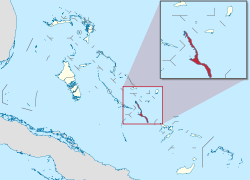Long Island, Bahamas
| District of Long Island | |
|---|---|
 |
|
| Coordinates: 23°10′35″N 75°05′46″W / 23.176499°N 75.096212°W | |
| Country |
|
| Island | Long Island |
| Established | 1996 |
| Government | |
| • Type | District Council |
| • Chief Councillor | Ian Knowles |
| • Deputy Chief Councillor | Dwayne Fox |
| Area | |
| • Total | 596 km2 (230 sq mi) |
| Population (2010) | |
| • Total | 3,094 |
| • Density | 5.2/km2 (13/sq mi) |
| Time zone | EST (UTC−5) |
| • Summer (DST) | EDT (UTC−4) |
| Area code(s) | 242 |
Long Island is an island in the Bahamas that is split by the Tropic of Cancer. Its capital is Clarence Town. Long Island is one of the Districts of the Bahamas and is known as the most scenic island in the Bahamas. The population is 3,094 inhabitants.
Long Island is about 130 kilometers (80 mi) long and 6 km (4 mi) wide at its widest point. The land area is 596 km2 (230 sq mi). Long Island is situated about 265 km (165 mi) southeast of the Bahamian capital of Nassau, which is located on the island of New Providence. The Tropic of Cancer runs through the northern quarter of the island.
The northeast side of Long Island is noted for its steep rocky headlands, while the southwest coast is noted for its broad white beaches with soft sand. The terrain ranges widely throughout the island, including white flat expanses from which salt is extracted, swamplands, beaches, and sloping (in the north) and low (in the south) hills.
Long Island is particularly noted for its caves, which have played a major role in the island's history. Dean's Blue Hole, located west of Clarence Town, is the world's second deepest underwater sinkhole, dropping to a depth of about 200 meters, making it more than double the depth of most other large holes.
Long Island is surrounded by small bays and inlets, including the large New Found Harbor west of Deadman's Cay, at approximately the midsection of the island. There are also smaller islands off-shore, including Sandy Cay.
The island was originally called by the Arawak name "Yuma." It was rechristened "Fernandina" by Christopher Columbus on his first voyage in 1492, during which Long Island is believed to have been his third stop, following San Salvador and Rum Cay to the east. Archaeological evidence, including ceremonial stools called duhos, shows that the Lucayan Taíno tribe settled on Long Island, probably in the island's cave system. After the demise of the Lucayans, who were carried as slaves to Hispaniola and Cuba, there was no large settlement until the arrival of the Loyalists.
...
Wikipedia
